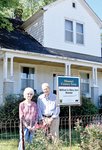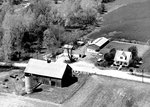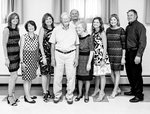All of his life Wilfred “Ferdie” Kremer, 95, has called the farmhouse near Frankenstein in which he was born home, and as of February 2020, the property has been in his family for 100 …
This item is available in full to subscribers.
We have recently launched a new and improved website. To continue reading, you will need to either log into your subscriber account, or purchase a new subscription.
If you are a current print subscriber, you can set up a free website account by clicking here.
Otherwise, click here to view your options for subscribing.
Please log in to continue |
|



All of his life Wilfred “Ferdie” Kremer, 95, has called the farmhouse near Frankenstein in which he was born home, and as of February 2020, the property has been in his family for 100 years.
“This has always been my home,” he said. “The only time I was away was when I was drafted into the Navy at the tail-end of World War II. The experience was good for me but I couldn’t get back to the farm fast enough.”
Upon his return from service, Ferdie met Mary Ann Broker, and the two married in 1949 at Our Lady of Help Catholic Church in Frankenstein. She was born in Valley Park, the fifth child and only daughter of Michael and Anna (Hanley Bengel) Broker.
They’ll celebrate their anniversary this month, and both are happy with the life they’ve built. “It’s hard to believe but I’m glad to be here,” said Mary Ann. “I don’t want to be anywhere else.”
The couple lived in the one-room lower floor of an older house in Frankenstein the first few years following their nuptials and bought the farm from Ferdie’s father, Adolph, in 1954.
ORIGINS OF THE KREMER FARM
Adolph and his wife, Anna nee Samson purchased the farm from her brother, Conrad, on Feb. 26, 1920. This land, about a mile south of Frankenstein, was part of the acreage homesteaded by the McKnight family.
On Oct. 8, 1930, Adolph expanded the farm by purchasing a 60-acre parcel on the west boundary of the farm from the estate of Martha “Mattie” McKnight.
During his farming days, Adolph witnessed the transition from animal-driven agriculture to mechanized farming. He acquired a tractor in the 1940s that began replacing the horse and mule teams; however, grain harvest using steam-driven threshing machines continued until about 1954, according to family history recorded in the book published on the 150th anniversary of Our Lady of Help Catholic Church.
The 30-foot steel silo was erected in 1951 next to the barn and was filled with corn silage, used as forage to feed cattle, for 30 consecutive years. Adolph was also an involved member of the community, always willing to help out neighbor, friend, or stranger. Because the farm was located on the main road to Linn, many travelers finding themselves mired in the road or stalled on the crossing at the creek, called on Adolph for help, to which he obliged. He also milled feed for neighbors and was a part of many crews that accomplished the necessary work of threshing, haying, and butchering that was the way of life on the farm at that time.
Neighbors always helped out each other, especially when the chore was complex and required many steps that one man could not do by himself. Butchering required at least two men, although a couple more hands made things easier. “Henry Troesser was always reliable and a master with the knife,” said Bob Kremer, who helps on the farm when he can. “He would help us, and we returned the favor, especially on the day after Thanksgiving, when he would butcher four or more hogs. Silo-filling was an even bigger event, which required several days of work at each farm and generally involved from six to 10 hands to get everything completed.”
Equipment would be set up one day, then cutting and chopping the corn began. Wagons filled with silage would continuously be hauled to the silo-filling site where it took four hands to get it blown into the silo, with one inside “tromping” it into place. “That nearly always was Henry’s job,” Bob explained. “If everything went smoothly, with no breakdowns, a silo could be filled in a couple of days. Then we moved on to the next farm. The most memorable part of silo-filling was the meals. The neighboring ladies would meet at the house where the crew was working and prepare a huge dinner (noon meal). The hands would break about noon, come to the house where the washtub was set up, and all would wash up, towel off, and go in and have a meal which included the staples, meat, potatoes, gravy, sauerkraut, and dessert. Afterward, there might be a little time for rest under the shade tree for a smoke and some casual talk, but work ensued fairly shortly. The entire process, similar to threshing in a previous era, was a real community interaction and time for socialization for both men and women. Similar descriptions can be made for haying crews and catching chickens or turkeys. Some chores such as catching chickens ended with a meal of baloney sandwiches, cookies, and other light snacks for the crew at 10 p.m. or later.”
Anna was a homemaker and nurtured the couple’s eight children during all those years on the farm. In addition to tending to her large family, she was also responsible for preparing meals for numerous farm hands hired seasonally to work in the crops. Often during busy times such as corn harvest, hands would stay overnight during the week, which added to the number of meals that had to be prepared. Anna was often baking bread every day in anticipation of the next day’s meals. She also tended the large garden, made butter and cheese from milk from the family dairy cow, oversaw making sauerkraut, helped with gathering eggs, and processing spring chicken and meats, which included making sausages and traditional German meat preparations. With all these chores, she was still able to propagate and tend to the many flowering plants that were both outside and inside the home. “Such was the life of a farm wife, but it goes without saying that Anna was one of the best cooks in the community,” Bob said.
THE HOMESTEAD
Local carpenter, and Ferdie’s uncle, Henry Kremer, built the home in which Ferdie and Mary Ann still reside. Limestone from the farm was quarried for use in the construction of the current church in Frankenstein in the early 1920s.
The farm still has 150 hogs plus corn and soybeans.
“Pigs have always been part of the farm,” said Russ Kremer, one of two sons who help manage the property.
Currently, swine are sold to Heritage Foods, a dedicated network of sustainable farmers who share a passion for raising hogs. At times, Adolph would have 10 or more brood sows, resulting in more butchering and market hogs than neighboring farms.
In the past, the family also grew wheat, oats, grain sorghum and hay, and raised cattle.
“We used to have horses and mules on the farm too,” Ferdie said, adding his father had broilers for several years, along with a family milking cow and laying hens.
“We always had a milk cow – one in particular that practically gave enough milk and other dairy products to raise at least six of us,” Bob said. “Some of the kids had some difficulty dealing with the daily milk ration at every meal, as described by my sister, Marie: ‘Every night we had a glass of milk with our supper and we could not have dessert or leave the kitchen table until it was all drunk down. The taste of the milk seemed to have a hint of grass our cow ate that day. There were a few times when I decided I had enough of that milk and did not want to drink it. There was no dessert for me. Dishes were cleaned, and the table was cleared, leaving me sitting at the table with my glass of milk. I would sit for hours wishing the milk would disappear as it got warmer and warmer. Finally, I’d give in and drink it (with help from Quick Mix or holding my nose). To this day, I am not a fan of a glass of milk.’”
In the past, the family grew hay and raised cattle.
“We used to have horses and mules on the farm too,” Ferdie said, adding his father had broilers for several years, along with a family milking cow and laying hens.
In addition to selling eggs for 50 cents a dozen, hatchling eggs were sold to hatcheries.
“We were blessed to have both sets of grandparents living within a mile or so,” Bob said. “They often helped out with gardening, and we would help them out, especially with their orchards. Grandpa Kremer had peaches and Grandpa Broker had cherries.”
One of the special places on the farm for kids was an area of Cedar Creek where a low-water crossing (“the slab”) was located to accommodate the county road. “All of us played there, whether throwing rocks at frogs and snakes, attempting to swim, or just getting wet, especially if the older girls were supposed to be minding the babies for Mom,” Bob said. “It is interesting that the next generation (our kids) now find as much fascination with the creek as we did.”
Bob lives in Columbia and is a retired soil scientist with the University of Missouri, from which he earned his degree.
“Growing up on the farm really developed my interest in agriculture,” he said. “I felt fortunate to go to college. It took a bit to get going but it worked out.”
Following the completion of his undergraduate studies, Bob was drafted into the military and when his enlistment ended, he married Mo. They have two children, Andrew, who married Amanda Hutzel and lives in Cincinnati, Ohio, and Erin, who married Anthony Moore and lives in Columbia.
Bob and Mo lived in Mississippi for five years while he earned a doctorate in soils and biochemistry. Bob then spent 40 years with USDA and MU and credits his life of agricultural study to his parents.
“It was a big influence on my life and career,” he said.
Russ agreed. “There was no better time or place to grow up,” he said. “This family and the Frankenstein community have been very influential I would say. I learned at an early age what it means to cooperate, show respect and live with morals. We learned how to look out for each other and what sustaining the economy looks like. We earned money and invested it back into the community’s Main Street businesses.”
Russ has lived all his life near the family farm.
“This will always be home,” he added. “I’ve traveled to places around the world and no matter how exotic or exciting those places are, I can’t wait to get back to the farm.”
Moving forward, Bob believes the farm will continue to thrive. “We’re committed to keeping it in the family for another 100 years,” he said.
They raised seven children on the farm, all of whom graduated from St. Mary’s elementary school in Frankenstein and Fatima High School.
In addition to Russ and Bob, the Kremer’s five daughters are Joyce Weidinger, who with her husband, Mark, has two daughters, Angie, who married John Schwartze and lives in St. Charles, and Kelley, who married Josh Hagemeyer and lives in Jefferson City, and a son, David and his wife, Jenna Sligar, who live in Denver, Colo.; Debra, who married Johnny Hammond; Karen, who with her husband Glenn Muenks, has two children, Connor and Claire; Marie Florence, who married Wynn Searle; and Roberta “Bertie,” who with her husband, Jason Rader, has a daughter, Anna, and a son, Jeremy.